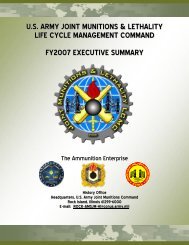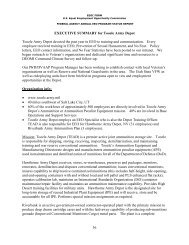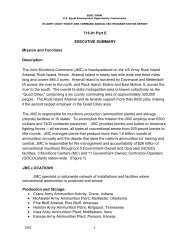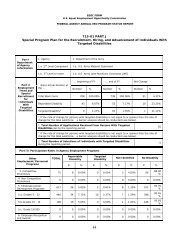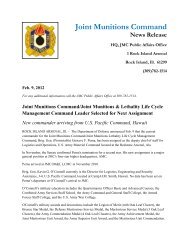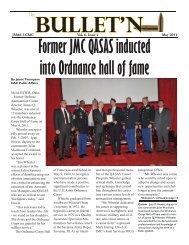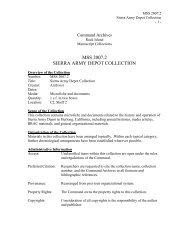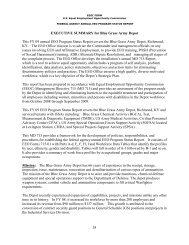History of the Ammunition Industrial Base - JMC - U.S. Army
History of the Ammunition Industrial Base - JMC - U.S. Army
History of the Ammunition Industrial Base - JMC - U.S. Army
Create successful ePaper yourself
Turn your PDF publications into a flip-book with our unique Google optimized e-Paper software.
companies in <strong>the</strong> U.S. with experienced personnel to produce explosives, and <strong>the</strong> capacity <strong>of</strong><br />
smokeless powder production had fallen to only 30 tons a day and TNT was lower at 12 tons a<br />
day. 30 Therefore, a large proportion <strong>of</strong> Ordnance funding obligated during <strong>the</strong> latter half <strong>of</strong> 1940<br />
went to new powder and explosives plants and for plants that loaded, assembled and packed<br />
(LAP) artillery. The OD signed its first contract with Dupont for construction <strong>of</strong> a smokeless<br />
powder works (Indiana Ordnance Works). Ano<strong>the</strong>r contract was approved for <strong>the</strong> construction<br />
<strong>of</strong> Radford Ordnance Works in Virginia with Hercules Powder Company as <strong>the</strong> operating<br />
contractor. By December 1940, a full year before Pearl Harbor, 22 new facilities were under<br />
way for shell loading and production <strong>of</strong> chemicals and explosives. 31<br />
By October 1941 several ammunition complexes were producing ammunition. By <strong>the</strong><br />
end <strong>of</strong> 1941 <strong>the</strong>re was at least one <strong>of</strong> every essential type <strong>of</strong> government owned ammunition<br />
plants incorporated into <strong>the</strong> industrial base to include TNT, DNT, tetryl, toluene, anhydrous<br />
ammonia, smokeless powder, bag loading, and shell loading plants. 32 After Pearl Harbor, an<br />
additional 25 facilities were authorized almost immediately and construction began between<br />
January and August 1942. A total <strong>of</strong> 112 plants were authorized and 84 were constructed in only<br />
a few years. 33<br />
The need for expansive buildup did not go unquestioned. The Truman Committee <strong>of</strong> <strong>the</strong><br />
Senate and <strong>the</strong> Tolan Committee <strong>of</strong> <strong>the</strong> House <strong>of</strong> Representatives expressed criticism in 1941.<br />
They thought <strong>the</strong> building <strong>of</strong> new plants was needless and <strong>the</strong> Ordnance Department was failing<br />
to fully utilize existing capability. They viewed <strong>Army</strong> procurement efforts as “helpless” in<br />
dealing with large corporations who were refusing to convert to wartime production. This<br />
perceived helplessness drove demand for new plant construction. They claimed <strong>the</strong> <strong>Army</strong><br />
wasted building materials, contributed to machine tool shortages, and delayed production. 34 The<br />
committee may have been justified in <strong>the</strong>ir arguments; however, <strong>the</strong>y failed to understand that<br />
<strong>the</strong> new construction would be for a bulk <strong>of</strong> ammunition commodities that simply could not be<br />
met through procurement efforts. In December 1941, <strong>the</strong> Under Secretary <strong>of</strong> War, Robert<br />
Patterson, defended <strong>Army</strong> proposals and answered <strong>the</strong> critique by <strong>the</strong> Senate and <strong>the</strong> House. 35<br />
The Secretary vigorously defended construction <strong>of</strong> ordnance facilities and assured <strong>the</strong><br />
Committees that <strong>the</strong> <strong>Army</strong> had not proceeded with base expansion <strong>of</strong> new plants except where<br />
necessary. These criticisms were quickly forgotten after <strong>the</strong> outbreak <strong>of</strong> war. What appeared to<br />
be over expansion in <strong>the</strong> fall <strong>of</strong> 1941, took an appearance <strong>of</strong> under expansion after Pearl Harbor.<br />
Wartime requirements escalated rapidly and placed strain on all existing ordnance facilities. 36<br />
By <strong>the</strong> time <strong>of</strong> <strong>the</strong> Pearl Harbor attack, it took an average <strong>of</strong> 9-11 months between contract and<br />
first operations when bringing a new capability on line.<br />
Despite <strong>the</strong> large numbers <strong>of</strong> plants, attempts at efficiency were being practiced. In<br />
several cases plants turned out more than one product. For example Badger Ordnance Works<br />
(BOW) in Wisconsin was constructed to produce three smokeless powder lines but was revised<br />
30<br />
Hammond, 3.<br />
31 Thomson & Mayo, 110-111.<br />
32 Hammond, 105.<br />
33 Hammond, 3; Thomson & Mayo, 110-113.<br />
34 Thomson & Mayo, 33.<br />
35 Records <strong>of</strong> <strong>the</strong> Under Secretary <strong>of</strong> War. Accessed at: http://www.archives.gov/research/holocaust/finding-<br />
aid/military/rg-107-2.html.<br />
36 Thomson & Mayo, 33.<br />
13



